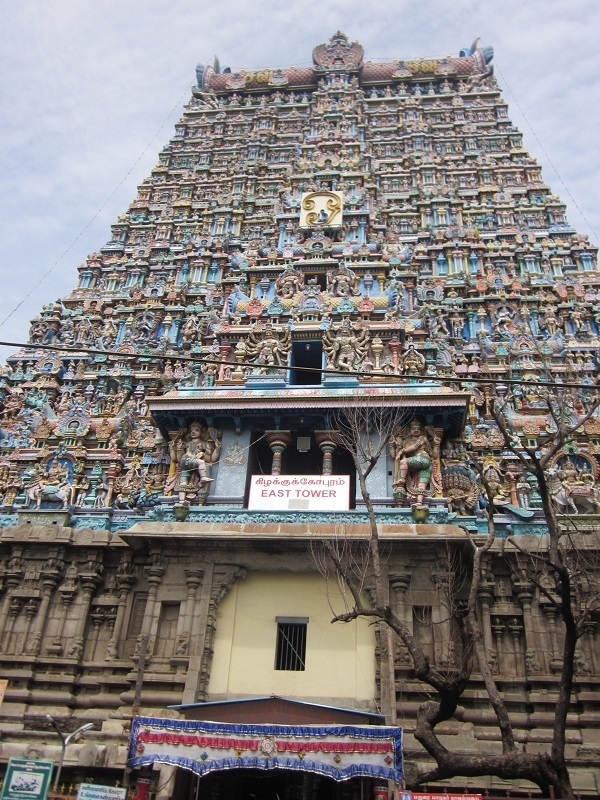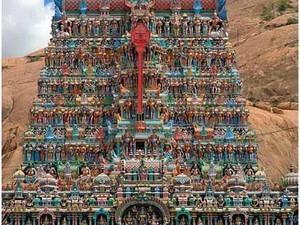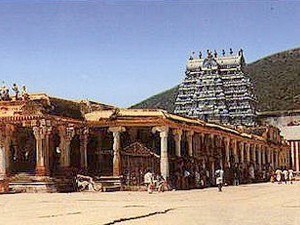Sri Meenakshi Sundareswarar Temple, Madurai - Timings, History, Architecture, Best Time to Visit
Photo Credit: Flickr
 #1 of 24 Places to Visit in Madurai
#1 of 24 Places to Visit in Madurai
 Distance (From Madurai Junction): 2 Kms
Distance (From Madurai Junction): 2 Kms
 Trip Duration (Including Travel): 2-3 Hours
Trip Duration (Including Travel): 2-3 Hours
 Transportation Options: Cab / Auto / Walk/Trek
Transportation Options: Cab / Auto / Walk/Trek
 Travel Tips: It usually takes about 2-3 hours to explore the Meenakshi temple. It can go up to 4-5 hours during festival season.
Travel Tips: It usually takes about 2-3 hours to explore the Meenakshi temple. It can go up to 4-5 hours during festival season.
About Sri Meenakshi Sundareswarar Temple
At a distance of 2 km from Madurai Junction Railway Station, Arulmigu Meenakshi Sundareswarar Temple, also known as Arulmigu Meenakshi Amman Thirukkovil, is a historic Hindu temple located on the southern bank of the Vaigai River in Madurai, Tamil Nadu, India. It is one of the biggest and most popular temples in India, and among the must-visit places as part of Madurai tour packages. The temple is dedicated to the goddess Meenakshi, a form of Parvati, her consort Sundareswarar, a form of Shiva and her brother Alagar, a form of Vishnu. The temple is theologically significant as it represents a confluence of the Shaivism, Shaktism and Vaishnavism denominations of Hinduism. It was shortlisted as one of the top 30 nominees for New Seven Wonders of the World. It is one of the the prime places of Pilgrimage in Tamilnadu. This temple is one of the Paadal Petra Sthalams, which are 275 temples of Shiva that are revered in the verses of Tamil Saiva Nayanars of the 6th-9th century CE.
History of Sri Meenakshi Sundareswarar Temple
The Madurai temple serves as the central and lifeline of the city of Madurai, which boasts a history spanning 2,500 years. The initial construction of the temple was undertaken by Kulasekara Pandya (1190 CE-1205 CE). He built the main sections of the three-tiered Gopuram at the entrance of the Sundareswarar Shrine, as well as the central area of the Goddess Meenakshi Shrine. Additionally, he established shrines dedicated to Natarajar and Surya adjacent to the main temple, along with Ayyanar to the east, Vinayagar to the south, Kariamal Perumal to the west, and Kali to the north. A Mahamandapam was also constructed during his reign.
In 1231, Maravarman Sundara Pandyan I erected a gopuram, which was later reconstructed, expanded, and named Sundara Pandya Thirukkopuram. The Chitra gopuram, located to the west and also referred to as Muttalakkum Vayil, was built by Maravarman Sundara Pandyan II between 1238 and 1251. This gopuram derives its name from the frescoes and reliefs that illustrate both secular and religious aspects of Hindu culture. Furthermore, Maravarman Sundara Pandyan II enhanced the Sundareswara shrine by adding a pillared corridor and the Sundara Pandyan Mandapam. After sustaining damage in the 14th century, the granite structure underwent renovations by Kumara Krishnappar post-1595.
Despite its ancient origins, the majority of the current temple complex was reconstructed following the 14th century CE, with additional repairs, renovations, and expansions occurring in the 17th century under the direction of Tirumala Nayaka. In the early 14th century, the temple faced devastation when the armies of the Delhi Sultanate, led by Malik Kafur, plundered it, stripping it of its treasures and ravaging the town of Madurai along with several other temple towns in South India. The present-day temple is largely a product of the rebuilding initiatives initiated by the rulers of the Vijayanagara Empire, who restored the core structure and reopened the temple. In the 16th century, the temple complex was further enlarged and fortified by Viswanatha Nayak, the first Nayak king of Madurai (1559-1600), under the guidance of Ariyanatha Mudaliar. The temple was substantially expanded to the current structure during the reign of Thirumalai Nayak between 1623 and 1655 CE.
Mythology of Sri Meenakshi Sundareswarar Temple
According to legend, Goddess Meenakshi was born to King Malayadwaja Pandya of Madurai and his queen, Kanchanamala. The royal couple had long prayed for a son, and after conducting a rigorous yajna, a three-year-old girl with three breasts emerged from the flames. A celestial voice proclaimed that the child was an incarnation of Parvati, and that her third breast would vanish upon meeting her destined spouse. Meenakshi matured into a formidable warrior, leading her armies on a digvijay, a campaign to conquer lands in all eight directions. Upon reaching the Himalayas, she encountered Shiva. At the moment she laid eyes on him, her third breast disappeared as foretold, and she recognized Shiva as her intended husband. Upon her return to Madurai, her father anointed her as the sovereign of Madurai and celebrated her marriage with great grandeur. This divine union is commemorated annually at the Meenakshi Amman temple, drawing thousands of devotees.
Architecture of Sri Meenakshi Sundareswarar Temple
Spread over an area of 45 acres of land, Sri Meenakshi Amman Temple is a massive complex measuring 254 by 237 meters. The temple is surrounded by 14 towers, the tallest of which, the famous Southern tower, rises to over 170 feet high built in the year 1559. The oldest gopuram is the eastern one, built by Maravarman Sundara Pandyan during 1216-1238. The west tower (gopuram) of the temple is the model on which the Tamil Nadu State Emblem is based. The temple has four entrances, while the entrance on the Eastern side being the main temple entrance.
There are several corridors, halls such as Aayirankaal (1000-pillared hall), Kilikoondu-mandapam, Golu-mandapam and Pudu-mandapam, and shrines inside the temple. The corridors and pillars are adorned with wonderful artwork. The Thousand Pillar Hall contains 985 (instead of 1000) carved pillars. It was built by Ariyanatha Mudaliar in 1569 and is currently houses a museum with artifacts collected from Madurai from the 8th century onwards. There are the Musical Pillars outside this hall towards the west. Each pillar produces a different musical note when struck. The temple is an architectural wonder with an estimated 33,000 sculptures in the temple. The sculptures depict the mythological stories, Shiva & Parvathi marriage scenes, etc.
The Meenakshi temple complex has two separate shrines for the goddess Meenakshi and Lord Sundareswara. The Amman shrine is on the south side, while the Shive shrine is more centrally placed, to the north, thus placing the goddess as the pradhana murti or the 'more important' within the complex. The sanctum of Meenakshi Amman shrine has the green stone image of Meenakshi, standing in bent-leg posture, holds a lotus, on which sits a green parrot. A distinct feature of Meenakshi in terms of iconography is the presence of parrot in her right hand which is generally associated with the Sri Vaishnava Alvar Andal.
The shrine for Sundareswarar is the largest within the complex and its entrance is aligned with the eastern gopuram. The shrine for Meenakshi is smaller, though theologically more important. Both the Meenakshi and Sundareswarar shrines have gold plated Vimanam over sanctum.The Sundareswarar shrine has a stone shivalinga under a stone cobra hood in the sanctum. In the northeast corner is another stone image of his consort. There is another metal image of Shiva called the Cokkar kept near the sanctum all day, and then carried in a palki daily to Meenakshi's chamber every evening so that the two can symbolically spend the night together. In the morning, the temple volunteers wake the divine couple and the symbolic Cokkar image is carried back to the Sundareswarar sanctum.
The sacred pond (Potramarai Kulam) inside the Meenakshi Amman Temple measures 165 feet by 120 feet is visited before entering the temple. The view of the temple is marvelous from the pond premises with towers raised on all sides. The walls on the western side of the temple pond are beautifully painted in color which depicts the legend behind the temple and scenes from the marriage of Shiva and Parvathi.
Festivals of Sri Meenakshi Sundareswarar Temple
The Meenakshi temple celebrates a festival each month according to the Tamil calendar. It draws approximately 15,000 visitors daily, with numbers rising to around 25,000 on Fridays. The annual 10-day Meenakshi Tirukalyanam festival which takes place in the Tamil month of Chittirai (April-May) is the most prominent festival of Madurai Temple that attracts over a million visitors. The festival is marked by vibrant festivities and a chariot procession. Other festivals celebrated at Madurai Temple include Navarathri in Purattasi, the Vasantham festival in Vaikasi, the Unjal Festival in Aani, the Mulai-Kottu festival in Aadi, the Aavani Moolam Aavani, the Kolattam festivals in Ayppasi and Karthikai months, the Arudhra Dharsan festival in Margali, the Thai month utsavam, and the Masi and Vasamtham utsavams in Panguni. The time required for darshan generally varies between 1 to 2 hours; however, it may increase to 3 to 4 hours during weekends and special occasions.
Dress Code & Other Restrictions of Sri Meenakshi Sundareswarar Temple
Visitors to the Meenakshi Amman Temple are required to dress in a conservative manner, ensuring that their legs and shoulders are adequately covered. Men are advised to wear shirts and trousers, dhotis, or pyjamas, while women should opt for sarees, salwar kameez, or other traditional garments that sufficiently cover their shoulders and legs.
Ladies hand-bags will not be allowed inside the temple complex. One can leave their bags, along with phones, at the cloak room.
Non-Hindus are not allowed inside the temple beyond the kodimaram (flagpole). However, authorities may permit non-Hindus to visit a particular deity in a temple if they submit a declaration affirming their faith in the deity and their commitment to adhere to the customs and practices of Hinduism, as well as the regulations of the temple.
Sri Meenakshi Sundareswarar Temple Timings
Monday: 5 AM to 12:30 PM & 4 PM to 9:30 PM
Tuesday: 5 AM to 12:30 PM & 4 PM to 9:30 PM
Wednesday: 5 AM to 12:30 PM & 4 PM to 9:30 PM
Thursday: 5 AM to 12:30 PM & 4 PM to 9:30 PM
Friday: 5 AM to 12:30 PM & 4 PM to 9:30 PM
Saturday: 5 AM to 12:30 PM & 4 PM to 9:30 PM
Sunday: 5 AM to 12:30 PM & 4 PM to 9:30 PM
Sri Meenakshi Sundareswarar Temple Entry Fee
General Entry is Free
Special darshan available for Rs. 100
Best Time to Visit Sri Meenakshi Sundareswarar Temple
The best time to visit the Meenakshi Temple are typically in the early morning or late afternoon, as these periods tend to have fewer visitors. If you intend to visit during festivals or significant religious occasions, particularly the Meenakshi Thirukalyanam festival, it is recommended to arrive early due to the increased number of attendees.
How to Reach Sri Meenakshi Sundareswarar Temple
Madurai has its own airport and railway station, providing excellent connectivity to all significant towns and cities within Tamil Nadu and across India. Visitors can utilize buses, auto-rickshaws, or taxis to access Meenakshi Temple from various locations within Madurai.
















